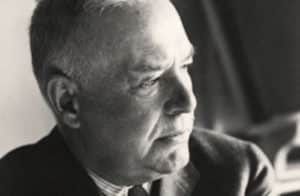< Return to Wallace Stevens Poems
Ballade of the Pink Parasol
I pray thee, where is the old-time wig.
And where is the lofty hat?
Where is the maid on the road in her gig.
And where is the fire-side cat?
Never was sight more fair than that.
Outshining, outreaching them all.
There in the night where lovers sat-
But where is the pink parasol?
Where in the park is the dark spadille
With scent of lavender sweet.
That never was held in the mad quadrille.
And where are the slippered feet?
Ah! we’d have given a pound to meet
The card that wrought our fall
The card that none other of all could beat-
But where is the pink parasol?
Where is the roll of the old calash.
And the jog of the light sedan?
Whence Chloe’s diamond brooch would flash
And conquer poor peeping man.
Answer me, where is the painted fan
And the candles bright on the wall;
Where is the coat of yellow and tan-
But where is the pink parasol?
Prince, these baubles are far away.
In the ruin of palace and hall.
Made dark by the shadow of yesterday–
But where is the pink parasol?
—Wallace Stevens
Did you enjoy Ballade of the Pink Parasol by Wallace Stevens? You might like this poetry book:
About Wallace Stevens
Wallace Stevens was born on October 2, 1879, in Reading, Pennsylvania and died on August 2, 1955, in Hartford, Connecticut. He won two National Book Awards and the Pulitzer Prize for poetry, along with the Bollingen Prize and the Frost Medal. He was one of the American poets who were considered the high priests of literary modernism, along with T.S. Eliot, William Carlos Williams, and Robert Frost. He was a presence in poetry for more than four decades and had an enormous impact on poetry’s substance and direction.

Wallace Stevens
Stevens, an impressive intellect, was both a poet and a kind of philosopher of aesthetics. The two can’t really be separated. He explored aesthetics as much as if not more than most other subjects. As a young man working in New York City after his graduation from Harvard, he was strongly influenced not only by poets but also by the contemporary art scene. He was in his early 30s when the New York Armory Show rocked the art world (and the American public) in 1913. He was friends with artists like Marcel Duchamp and Man Ray and poets like William Carlos Williams.
Wallace Stevens was also a businessman. He first tried his hand at journalism, turned to law school, and then took his law degree to the insurance industry. After working with a number of smaller firms, he eventually joined the Hartford Insurance Company, where he worked until his death in 1955.
His work required him to travel extensively, all over the eastern United States, the Midwest, and Texas, and he maintained a blistering travel schedule for a long time. The schedule had occasional benefits to his poetry, such as stopping by the offices of Harriet Monroe at Poetry magazine when he was in Chicago. But while he was often encouraged to teach or pursue a more academic profession, he chose to stay with his insurance company, eventually reaching the office of vice president of the Surety Division.
As for Wallace Stevens the family man, the portrait is less flattering. His parents did not attend his marriage to Elsie in their hometown of Reading, Pennsylvania, as they did not consider it a suitable match. He broke with his father over it, and he didn’t see him again until his father’s funeral. He was not especially close to his two brothers or his two sisters, but he would grow closer to their children after his siblings’ deaths. As for his relationship with his wife, while there’s not even a wisp of a rumor of unfaithfulness, it’s clear that Stevens was unhappy in his marriage. Elsie rarely traveled with him, even for vacations; Stevens loved his trips with his drinking friends to Key West and similar points south. And his drinking often begat boorish behavior, such as when he insulted Ernest Hemingway and paid for it with black eyes.
Stevens left behind an extensive writing record: eight poetry collections published during his lifetime, including The Collected Poems, published in 1954 (which won both the National Book Award and the Pulitzer Prize), and a collection of essays, The Necessary Angel (1951). Works published after his death include Opus Posthumous (1957), Collected Poetry and Prose published by the Library of America in 1997, and Selected Poems published by Alfred A. Knopf in 2009. His daughter Holly Stevens also edited his letters, published in 1966.
Stevens was a major presence in American poetry and letters. He was often controversial but never boring. He wrote in the flood time of literary modernism and helped shape it and channel it.
(bio by Glynn Young)
That’s it for Ballade of the Pink Parasol by Wallace Stevens. You can check out more of his work:
